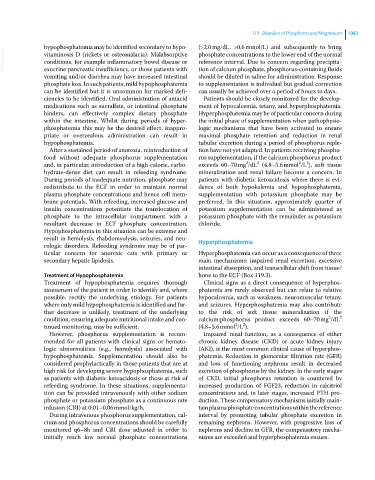Page 1145 - Clinical Small Animal Internal Medicine
P. 1145
119 Disorders of Phosphorus and Magnesium 1083
hypophosphatemia may be identified secondary to hypo (>2.0 mg/dL, >0.6 mmol/L) and subsequently to bring
VetBooks.ir vitaminosis D (rickets or osteomalacia). Malabsorptive phosphate concentrations to the lower end of the normal
reference interval. Due to concern regarding precipita
conditions, for example inflammatory bowel disease or
exocrine pancreatic insufficiency, or those patients with
should be diluted in saline for administration. Response
vomiting and/or diarrhea may have increased intestinal tion of calcium phosphate, phosphorus‐containing fluids
phosphate loss. In such patients, mild hypophosphatemia to supplementation is individual but gradual correction
can be identified but it is uncommon for marked defi can usually be achieved over a period of hours to days.
ciencies to be identified. Oral administration of antacid Patients should be closely monitored for the develop
medications such as sucralfate, or intestinal phosphate ment of hypocalcemia, tetany, and hyperphosphatemia.
binders, can effectively complex dietary phosphate Hyperphosphatemia may be of particular concern during
within the intestine. Whilst during periods of hyper the initial phase of supplementation when pathophysio
phosphatemia this may be the desired effect, inappro logic mechanisms that have been activated to ensure
priate or overzealous administration can result in maximal phosphate retention and reduction in renal
hypophosphatemia. tubular excretion during a period of phosphorus reple
After a sustained period of anorexia, reintroduction of tion have not yet adapted. In patients receiving phospho
food without adequate phosphorus supplementation rus supplementation, if the calcium:phosphorus product
2
2
2
2
and, in particular, introduction of a high‐calorie, carbo exceeds 60–70 mg /dL (4.8–5.6 mmol /L ), soft tissue
hydrate‐dense diet can result in refeeding syndrome. mineralization and renal failure become a concern. In
During periods of inadequate nutrition, phosphate may patients with diabetic ketoacidosis where there is evi
redistribute to the ECF in order to maintain normal dence of both hypokalemia and hypophosphatemia,
plasma phosphate concentrations and hence cell mem supplementation with potassium phosphate may be
brane potentials. With refeeding, increased glucose and preferred. In this situation, approximately quarter of
insulin concentrations potentiate the translocation of potassium supplementation can be administered as
phosphate to the intracellular compartment with a potassium phosphate with the remainder as potassium
resultant decrease in ECF phosphate concentration. chloride.
Hypophosphatemia in this situation can be extreme and
result in hemolysis, rhabdomyolysis, seizures, and neu Hyperphosphatemia
rologic disorders. Refeeding syndrome may be of par
ticular concern for anorexic cats with primary or Hyperphosphatemia can occur as a consequence of three
secondary hepatic lipidosis. main mechanisms: impaired renal excretion, excessive
intestinal absorption, and transcellular shift from tissue/
Treatment of Hypophosphatemia bone to the ECF (Box 119.3).
Treatment of hypophosphatemia requires thorough Clinical signs as a direct consequence of hyperphos
assessment of the patient in order to identify and, where phatemia are rarely observed but can relate to relative
possible, rectify the underlying etiology. For patients hypocalcemia, such as weakness, neuromuscular tetany,
where only mild hypophosphatemia is identified and fur and seizures. Hyperphosphatemia may also contribute
ther decrease is unlikely, treatment of the underlying to the risk of soft tissue mineralization if the
2
2
condition, ensuring adequate nutritional intake and con calcium:phosphorus product exceeds 60–70 mg /dL
2
2
tinued monitoring, may be sufficient. (4.8–5.6 mmol /L ).
However, phosphorus supplementation is recom Impaired renal function, as a consequence of either
mended for all patients with clinical signs or hemato chronic kidney disease (CKD) or acute kidney injury
logic abnormalities (e.g., hemolysis) associated with (AKI), is the most common clinical cause of hyperphos
hypophosphatemia. Supplementation should also be phatemia. Reduction in glomerular filtration rate (GFR)
considered prophylactically in those patients that are at and loss of functioning nephrons result in decreased
high risk for developing severe hypophosphatemia, such excretion of phosphorus by the kidney. In the early stages
as patients with diabetic ketoacidosis or those at risk of of CKD, initial phosphorus retention is countered by
refeeding syndrome. In these situations, supplementa increased production of FGF23, reduction in calcitriol
tion can be provided intravenously with either sodium concentrations and, in later stages, increased PTH pro
phosphate or potassium phosphate as a continuous rate duction. These compensatory mechanisms initially main
infusion (CRI) at 0.01–0.06 mmol/kg/h. tain plasma phosphate concentrations within the reference
During intravenous phosphorus supplementation, cal interval by promoting tubular phosphate excretion in
cium and phosphorus concentrations should be carefully remaining nephrons. However, with progressive loss of
monitored q6–8h and CRI dose adjusted in order to nephrons and decline in GFR, the compensatory mecha
initially reach low normal phosphate concentrations nisms are exceeded and hyperphosphatemia ensues.

